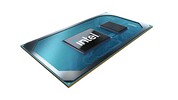AMD Ryzen 5 3550H vs Intel Core i3-1115G4 vs Intel Core i7-1195G7
AMD Ryzen 5 3550H
► remove from comparison
The AMD Ryzen 5 3550H is a mobile SoC that was announced in January 2019. It combines four Zen+ cores (8 threads) clocked at 2.1 GHz to 3.7 GHz with a Radeon RX Vega 8 graphics adapter with 8 CUs (512 Shaders) clocked at up to 1,200 MHz. Compared to the similar Ryzen 5 3500U, the 3550H offers a 20 Watt higher TDP and therefore a better performance under long periods of load. The integrated dual-channel memory controller supports up to DDR4-2400 memory. As the features of the Picasso APUs are the same compared to the Raven Ridge predecessors, we point to our Raven Ridge launch article.
The Picasso SoCs use the Zen+ microarchitecture with slight improvements that should lead to a 3% IPS (performance per clock) improvements. Furthermore, the 12 nm process allows higher clock rates at similar power consumptions.
Performance
The average 3550H in our database proves to be a solid mid-range CPU, its multi-thread benchmark scores hovering close to those of the Intel Core i7-10710U and the Core i5-8257U. Which is a little slow for an H-class processor, as of late 2021, but still more than enough for the vast majority of apps and games, provided one is fine with having to wait a little longer than usual for that 4K video encoding job to get completed.
Thanks to its decent cooling solution and sufficiently high CPU power limits, the Pavilion Gaming 15-ec0002ng is among the fastest laptops powered by the 3550H that we know of. It can be more than 20% faster in CPU-bound workloads than the slowest system featuring the same chip in our database, as of August 2023.
Power consumption
This Ryzen 5 series chip has a default TDP (also known as the long-term power limit) of 35 W. Laptop makers are free to reduce that value significantly with 12 W being the minimum AMD-recommended value. Clock speeds and performance would take a hit as a result; either way, that's a little too high to allow for passively cooled designs.
Last but not the least, the AMD Ryzen 5 3550H is built with a 12 nm process for lower-than-average, as of mid 2023, energy efficiency.
Intel Core i3-1115G4
► remove from comparison
The Intel Core i3-1115G4 is a dual-core SoC for laptops and Ultrabooks based on the Tiger Lake-U generation (UP3) that was launched in September 2020. It integrates two Willow Cove processor cores (4 threads thanks to HyperThreading). Each core can clock from 3 GHz (base speed) to 4.1 GHz (single- and dual-core boost). The faster Core i5 and i7 models offer more cores and are therefore significantly faster.
Another novelty is the integrated Xe graphics card based on the completely new Gen 12 architecture. In the i3-1115G4 Intel is naming the GPU UHD Graphics and offers only 48 of the 96 EUs clocked at 400 - 1250 MHz. GPU and CPU can together use the 6 MB of L3 cache.
Furthermore, Tiger Lake SoCs add PCIe 4 support (four lanes), AI hardware acceleration, and the partial integration of Thunderbolt 4 / USB 4 and WiFi 6 in the chip.
The chip is produced on the second-gen 10 nm Intel SuperFin process that should be comparable to the 7 nm TSMC process (e.g. Ryzen 4000 series).
Performance
Multi-thread peformance is most comparable to what the Intel Core i5-8250U and the AMD Ryzen 5 3450U deliver. This makes the i3 a more than decent option for day-to-day tasks; that said, any workload of the more taxing kind (such as exporting a high-bitrate, hour long UHD video) will be enough to bring the i3 to its knees.
Thanks to its decent cooling solution and a long-term CPU power limit of 25 W, the ThinkPad L15 G2-20X4S0KU00 is one of the fastest laptops powered by the 1115G4 we know of. It can be more than 20% faster in CPU-bound workloads than the slowest system featuring the same chip in our database, as of August 2023.
Power consumption
This Core i3 series chip has a default TDP of 12 W to 28 W, the expectation being that laptop makers will go for a higher value in exchange for higher performance. Either way, that's a tad too high to allow for passively cooled laptops, tablets, mini-PCs.
The Core i3-1115G4 is built with Intel's third-gen 10 nm process marketed as SuperFin for decent, as of mid 2022, energy efficiency.
Intel Core i7-1195G7
► remove from comparison
The Intel Core i7-1195G7 is a quad-core SoC from the Tiger Lake-UP3 product family designed for thin laptops and Ultrabooks that was introduced in 2021. It integrates four Willow Cove processor cores (8 threads thanks to Hyper-Threading). The base clock (minimum) depends on the configured TDP and can range from 1.3 GHz (12 Watt TDP) up to 2.9 GHz (28 W). The Turbo on one core can reach up to 5 GHz (Turbo Boost 3.0). All cores can reach up to 4.6 GHz. The i7-1195G7 is part of the Tiger Lake UP3 refresh and is the fastest CPU of the Tiger-Lake U line.
Furthermore, Tiger Lake SoCs supports four lanes of PCIe 4, AI hardware acceleration, and the partial integration of Thunderbolt 4/USB 4 and Wi-Fi 6E in the chip.
The 1195G7 integrates the Intel Iris Xe graphics adapter with 96 EUs clocked at 400 - 1400 MHz. The GPU and CPU can together use the 12 MB of L3 cache.
Performance
The average 1195G7 in our database matches the Intel Core i5-10300H in multi-thread performance while, perhaps surprisingly, lagging behind the AMD Ryzen 3 5300U. The makes the i7 a decent lower mid-range chip, as of early 2022. It'll run most apps with virtually no delays or slowdowns which is what the vast majority of users wants.
Thanks to its decent cooling solution and a long-term CPU power limit of slightly more than 30 W, the VAIO SX14 VJS144X0111K is among the fastest laptops built around the 1195G7 that we know of. It can be about 40% faster in CPU-bound workloads than the slowest system featuring the same chip in our database, as of August 2023.
Power consumption
This Core i7 series chip has a default TDP of 12 W to 28 W, the expectation being that laptop makers will go for a higher value in exchange for higher performance. Either way, that's a tad too high to allow for passively cooled designs.
The i7-1195G7 is built with Intel's 3rd generation 10 nm process marketed as SuperFin for below average, as of early 2023, energy efficiency.
| Model | AMD Ryzen 5 3550H | Intel Core i3-1115G4 | Intel Core i7-1195G7 | ||||||||||||||||||||||||||||||||||||||||||||||||||||||||||||||||||||||||||||||||||||||||
| Codename | Picasso-U (Zen+) | Tiger Lake-UP3 | Tiger Lake-UP3 | ||||||||||||||||||||||||||||||||||||||||||||||||||||||||||||||||||||||||||||||||||||||||
| Series | AMD Picasso (Ryzen 3000 APU) | Intel Tiger Lake | Intel Tiger Lake | ||||||||||||||||||||||||||||||||||||||||||||||||||||||||||||||||||||||||||||||||||||||||
| Series: Tiger Lake Tiger Lake-UP3 |
|
|
| ||||||||||||||||||||||||||||||||||||||||||||||||||||||||||||||||||||||||||||||||||||||||
| Clock | 2100 - 3700 MHz | 3000 - 4100 MHz | 2900 - 5000 MHz | ||||||||||||||||||||||||||||||||||||||||||||||||||||||||||||||||||||||||||||||||||||||||
| L1 Cache | 384 KB | 160 KB | 320 KB | ||||||||||||||||||||||||||||||||||||||||||||||||||||||||||||||||||||||||||||||||||||||||
| L2 Cache | 2 MB | 2.5 MB | 5 MB | ||||||||||||||||||||||||||||||||||||||||||||||||||||||||||||||||||||||||||||||||||||||||
| L3 Cache | 4 MB | 6 MB | 12 MB | ||||||||||||||||||||||||||||||||||||||||||||||||||||||||||||||||||||||||||||||||||||||||
| Cores / Threads | 4 / 8 | 2 / 4 | 4 / 8 | ||||||||||||||||||||||||||||||||||||||||||||||||||||||||||||||||||||||||||||||||||||||||
| TDP | 35 Watt | 28 Watt | 28 Watt | ||||||||||||||||||||||||||||||||||||||||||||||||||||||||||||||||||||||||||||||||||||||||
| Transistors | 4500 Million | ||||||||||||||||||||||||||||||||||||||||||||||||||||||||||||||||||||||||||||||||||||||||||
| Technology | 12 nm | 10 nm | 10 nm | ||||||||||||||||||||||||||||||||||||||||||||||||||||||||||||||||||||||||||||||||||||||||
| max. Temp. | 105 °C | 100 °C | 100 °C | ||||||||||||||||||||||||||||||||||||||||||||||||||||||||||||||||||||||||||||||||||||||||
| Socket | FP5 | BGA1449 | BGA1449 | ||||||||||||||||||||||||||||||||||||||||||||||||||||||||||||||||||||||||||||||||||||||||
| Features | DDR4-2400 RAM, PCIe 3, MMX (+), SSE, SSE2, SSE3, SSSE3, SSE4.1, SSE4.2, SSE4A, AES, AVX, AVX2, FMA3, SHA | DDR4-3200/LPDDR4x-3733 RAM, PCIe 4, 4 GT/s bus, DL Boost, GNA, MMX, SSE, SSE2, SSE3, SSSE3, SSE4.1, SSE4.2, AVX, AVX2, AVX-512, BMI2, ABM, FMA, ADX, VMX, SMEP, SMAP, EIST, TM1, TM2, HT, Turbo, SST, AES-NI, RDRAND, RDSEED, SHA | DDR4-3200/LPDDR4x-4266 RAM, PCIe 4, 4 GT/s, DL Boost, GNA, MMX, SSE, SSE2, SSE3, SSSE3, SSE4.1, SSE4.2, AVX, AVX2, AVX-512, BMI2, ABM, FMA, ADX, SMEP, SMAP, EIST, TM1, TM2, HT, Turbo, SST, AES-NI, RDRAND, RDSEED, SHA | ||||||||||||||||||||||||||||||||||||||||||||||||||||||||||||||||||||||||||||||||||||||||
| iGPU | AMD Radeon RX Vega 8 (Ryzen 2000/3000) ( - 1200 MHz) | Intel UHD Graphics Xe G4 48EUs (400 - 1250 MHz) | Intel Iris Xe Graphics G7 96EUs (400 - 1400 MHz) | ||||||||||||||||||||||||||||||||||||||||||||||||||||||||||||||||||||||||||||||||||||||||
| Architecture | x86 | x86 | x86 | ||||||||||||||||||||||||||||||||||||||||||||||||||||||||||||||||||||||||||||||||||||||||
| Announced | |||||||||||||||||||||||||||||||||||||||||||||||||||||||||||||||||||||||||||||||||||||||||||
| Manufacturer | www.amd.com | ark.intel.com | ark.intel.com |
Benchmarks
Average Benchmarks AMD Ryzen 5 3550H → 100% n=39
Average Benchmarks Intel Core i3-1115G4 → 102% n=39
Average Benchmarks Intel Core i7-1195G7 → 147% n=39
* Smaller numbers mean a higher performance
1 This benchmark is not used for the average calculation













